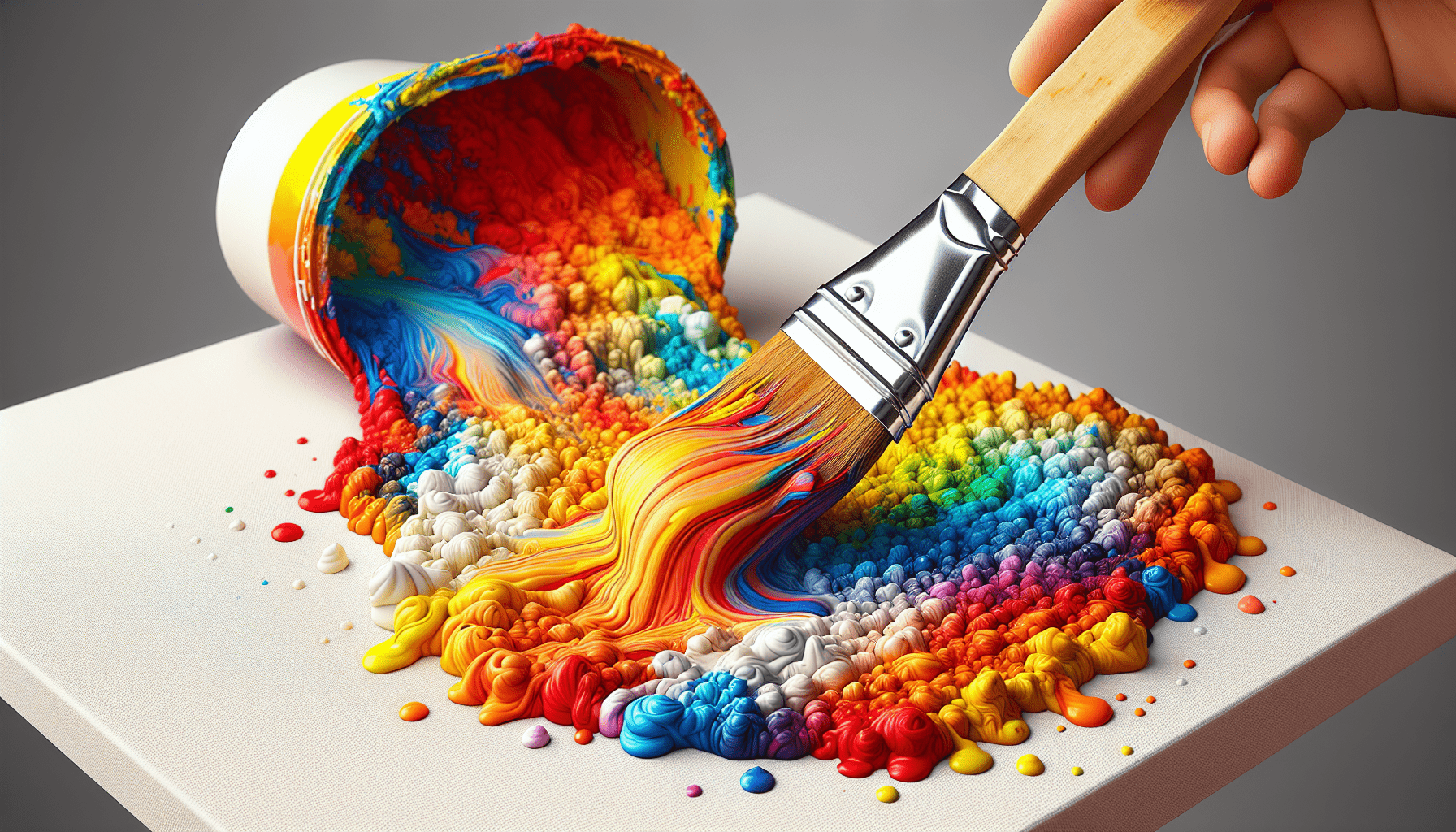Have you ever wondered whether poster paint can be used on walls? This question is essential for individuals considering creative decorating methods or DIY projects. Whether you want to add a splash of color to a room or create a mural, understanding the properties and limitations of poster paint is crucial. This article will explore the pros and cons of using poster paint on walls, offer comparisons with other types of paint, and provide practical advice on how you might make poster paint work for your wall decoration needs.
What is Poster Paint?
Poster paint, also known as tempera paint, is a water-based paint commonly used for children’s art projects. It is easy to use, non-toxic, and washes off easily, making it an ideal choice for school projects and casual crafting.
Composition Overview
The basic ingredients of poster paint include water, pigment, and a binder. The pigment gives the paint its color, the water serves as a solvent, and the binder helps the pigment adhere to surfaces. Because it is water-soluble, poster paint has a relatively short drying time, which is useful for projects requiring quick results.
Common Uses
Poster paint is typically used on paper, cardboard, and other porous surfaces. It is popular in educational settings, art workshops, and the like due to its easy application and removal. However, its suitability for wall applications is a different matter that requires a closer look.
Pros of Using Poster Paint on Walls
Before making the decision to use poster paint on walls, it’s helpful to understand its advantages:
Affordable and Easily Accessible
Poster paint is generally less expensive compared to other specialized wall paints. It can be found in almost any craft or stationary store, which makes it convenient for spontaneous projects.
Vibrant Colors
Poster paint tends to have bright and vivid colors, which can be very appealing for creating eye-catching designs or murals. You can mix colors easily to create custom shades without requiring complex color mixing techniques or expensive tools.
Easy Clean-Up
One of the most favorable characteristics of poster paint is its easy clean-up. If a mistake is made, it can often be corrected with water and soap, making it less intimidating for novice painters or children’s projects.

Cons of Using Poster Paint on Walls
While poster paint has its benefits, it also has several limitations when used on walls:
Lack of Durability
Poster paint is not formulated to withstand the wear and tear that wall surfaces typically endure, such as cleaning or abrasion. Over time, the paint may fade, chip, or peel, necessitating frequent touch-ups or even complete reapplications.
Poor Adhesion
Due to its formulation, poster paint does not adhere as strongly to non-porous surfaces, such as walls. This can result in an uneven finish, streaking, or even flaking.
Water Sensitivity
Because it’s a water-based paint, poster paint is highly susceptible to moisture. A wall painted with poster paint can be easily damaged by water, making it an unsuitable choice for areas exposed to humidity, such as bathrooms or kitchens.
Comparison with Other Types of Paint
To help you make a more informed decision, it’s useful to compare poster paint with other types of paint commonly used for walls.
| Type of Paint | Durability | Color Vibrancy | Ease of Use | Cost | Recommended Use |
|---|---|---|---|---|---|
| Poster Paint | Low | High | High | Low | Temporary art projects |
| Acrylic Paint | High | High | Moderate | Moderate | Long-lasting wall murals |
| Latex Paint | High | Moderate | Moderate | Moderate | Interior wall painting |
| Oil Paint | Very High | Very High | Low | High | High-quality murals |
| Chalk Paint | Moderate | Low | High | Moderate | Decorative finishes |
Acrylic Paint
Acrylic paint is a strong candidate for wall painting due to its durability and water-resistant qualities. It dries quickly and offers a vibrant finish, much like poster paint, but with added longevity.
Latex Paint
Latex paint is another excellent option, especially for interior walls. It offers good durability and is relatively easy to use. Unlike poster paint, latex paint can resist moisture and can be washed, making it a practical choice for most rooms.
Oil Paint
Oil paint provides a rich, vibrant finish and exceptional durability. However, it requires solvents for cleanup and has a much longer drying time compared to water-based paints. It’s often used for high-quality art projects and murals.
Chalk Paint
Chalk paint offers a matte finish and is often used for a vintage or shabby-chic look. While not as durable as acrylic or latex paint, it’s easier to work with and can be ideal for custom decorative touches on walls.

Preparation and Application Tips
If you still wish to use poster paint on your walls, preparation and application methods can make a significant difference in the outcome.
Surface Preparation
- Clean the Surface: Ensure the wall is clean and free of dust, dirt, and grease. A mild detergent solution works well for most surfaces.
- Priming: Apply a coat of primer suitable for water-based paints. This helps the paint adhere better to the surface and can mitigate some of poster paint’s adhesion issues.
Application Techniques
- Layering: Apply the poster paint in multiple thin layers rather than one thick coat for a more even finish.
- Sealing: Use a clear acrylic sealer once the paint is dry to provide some protection against moisture and wear. This can help extend the lifespan of your artwork.
Safety and Environmental Considerations
Another critical aspect to consider is the safety and environmental impact of using poster paint on walls.
Non-Toxic Ingredients
Poster paint is generally non-toxic, which makes it safe for use in children’s rooms or in areas where food is prepared. However, always check the label to ensure there are no harmful additives.
Disposal
Because it is water-based, poster paint is relatively easy to clean up, but proper disposal is essential. Avoid pouring leftover paint down the drain. Instead, allow it to dry completely and dispose of it with your regular waste, or follow your local environmental guidelines for disposing of paint.
Case Studies
To provide a practical perspective, let’s examine some real-life scenarios where poster paint was used on walls.
Classroom Art Projects
In many schools, poster paint is used for temporary wall art. Because it’s non-toxic and easy to clean, it’s ideal for classrooms, where permanent changes are not desirable.
Community Murals
Some community projects use poster paint for temporary murals. While poster paint offers vibrant colors, these murals are often short-lived and require frequent maintenance.
Home Décor
In some DIY home décor projects, poster paint has been used to create accent walls or borders. While the results can be visually stunning, durability remains a common issue, leading to a need for frequent touch-ups.
Expert Opinions
Gathering insights from professionals who have experience using poster paint on walls can illuminate the topic further.
Art Teachers
Many art teachers advise against using poster paint for long-term projects. They often recommend acrylic paints instead due to their similar workability but increased durability.
Professional Painters
Most professional painters typically avoid poster paint for walls, opting instead for paints specifically formulated for different materials and environments. They value the longevity and resilience of acrylic, latex, or oil-based paints.
Environmentalists
From an environmental perspective, the non-toxic nature of poster paint is a plus, but they often advise on responsible usage and disposal practices.
Conclusion
In summary, while poster paint offers some advantages like affordability, ease of use, and vibrant colors, its limitations make it less than ideal for wall applications. Factors such as durability, adhesion, and water sensitivity pose significant challenges. Nonetheless, with careful preparation and the right techniques, it is possible to use poster paint for temporary or experimental wall art. For more lasting solutions, considering alternatives like acrylic or latex paint can be a more effective approach. By weighing the pros and cons, you can make an informed decision that best suits your project’s needs.



